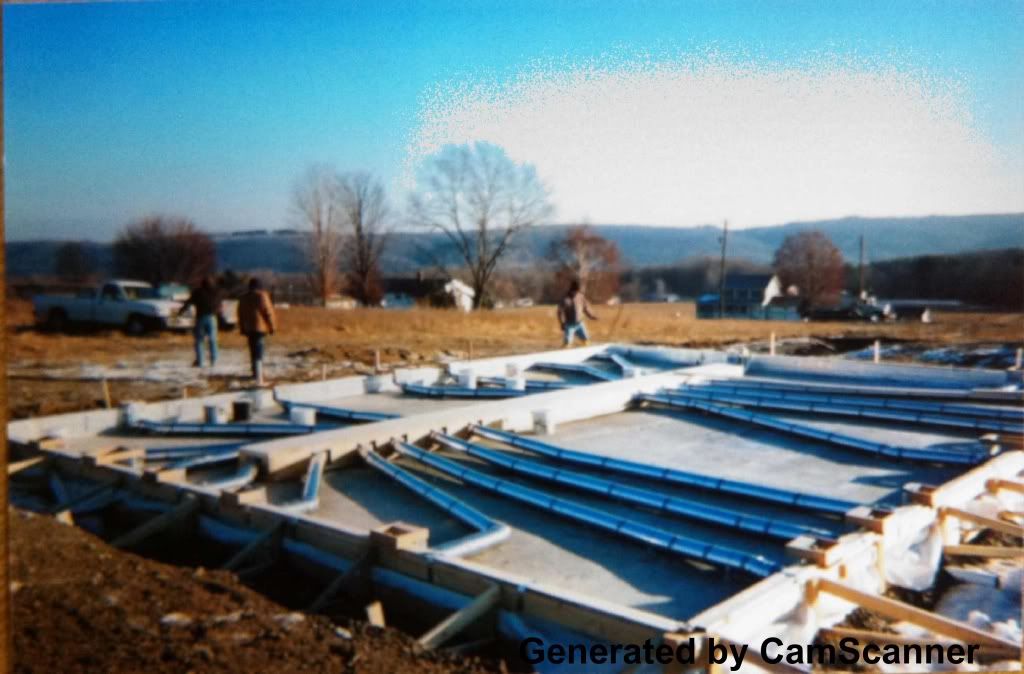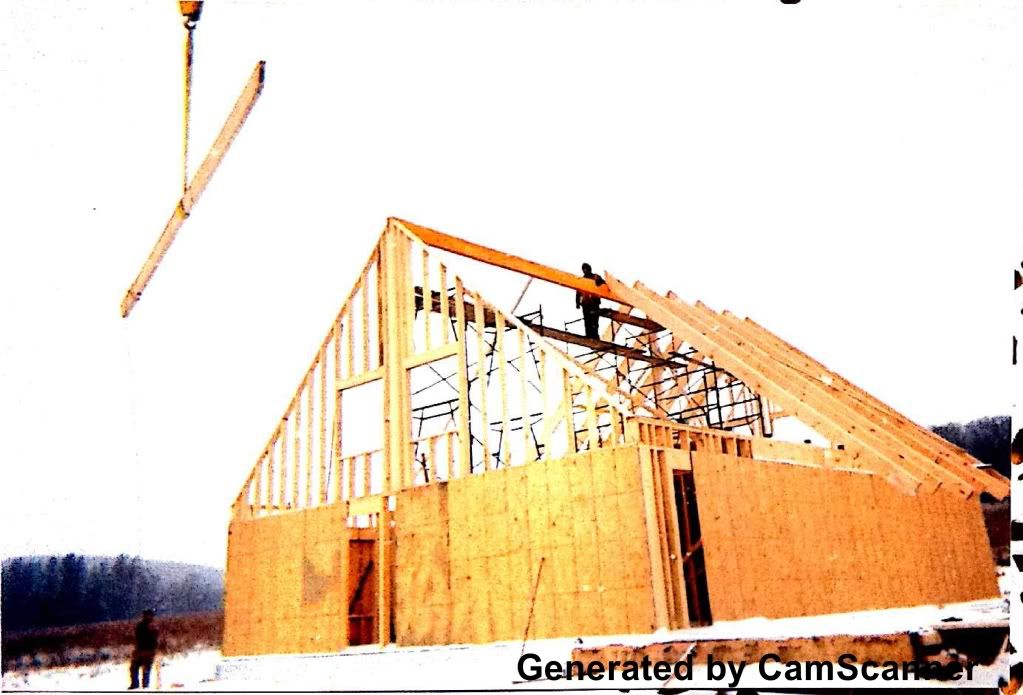A few years ago, my mother was fortunate enough to come across an amazing piece of old farmland for a very reasonable price. She had longed to build her own home for as long as I can remember, so this was an incredible opportunity for her. Although she had once looked at geodesic dome homes (and other related structures), she finally settled on passive solar construction. With the help of her designer, Bruce, she was able to construct a chalet style contemporary passive solar home.
 |
| The solar battery. |
To begin construction, the workers first laid down a solar battery that would be encased in a 12 inch thick concrete slab, the purpose of which is to retain the sun's energy and heat to be fed back into the house. How does this happen? The house is equipped with a 3-stage fan system that circulates the heat from the slab all the way up to the top of the loft, allowing the entire house to be the same temperature at all times. My mother's house has a loft instead of a full second floor so the distance from the living room floor to the ceiling is 30 feet. Thanks to this system, the entirety of those 30 feet is the same temperature.
 |
| It looks like a spider, eh? |
In order to get heat into the house in the first place, it is positioned perfectly to get the most sun all day long. There are two large 'heater' windows on the front of her house, which bring in the majority of the heat, and all the windows on the east side of her house also contribute. In the summer, these windows must be covered lest the house becomes a proverbial sauna as I can attest, so they are fitted with solar shades. In the winter, if it is not sunny for several days in a row, my mother uses her wood-burning stove, which is enough to keep the house comfortable most of the time. This past winter, my mother only had to use supplementary heating (electric) about two or three times when the temperatures went into single or negative digits.
 |
| The slab. |
As you may imagine, her house is very heavily insulated and is generally a thicker than normal home. The layout of the inside of the house also serves the purpose of airflow. Each room has several vents supplied by the 3-stage system and when all the doors are open, the house literally helps itself stay at a constant temperature because of the circulation. When my mother spent a month near my home before Piper was born (from Feb. to March), her house never went below 50 degrees - for an entire month!
 |
| My mother in her "kitchen." |
Though she loves her house, she thinks that if she ever builds again she would add geothermal energy to the house in addition to the passive solar to make it really, really efficient. So why am I telling you all of this? For a number of reasons, really.
1. You don't have to have the same house everyone else has. There is a tendency here to "go with the flow" in terms of what we know and "what the neighbors are doing." However, if we dig a little deeper, we might find that there is a better option out there for everyone involved. Any house plan can be turned into a passive solar home, so don't think you'd be giving up your dream home to make it passive solar. If you can dream it, they can build it.
2. I like saving money and I bet you do too. Though it can take 5 - 6 years to see a "major" improvement in the heating cost of a passive solar house, you WILL see a difference. This past winter my mother spent $600 on wood and that was it. Not an overly impressive number, but not the most expensive either (she heats about 1300 sq feet). Over time though, this number will likely get smaller as the house works better and better each year.
 | |||
| Lowering the 26ft beam. |
3. I am very passionate about this subject because I hate waste and to me, not using the sun's power is wasteful. When you start to understand how much of the Earth we could be using to solve our problems (instead of destroying it and creating new problems), the idea of a "traditional" house might make you ill. While you're at it, get a composting toilet, rain barrel and some solar lights to light up your yard.
 |
| Note the two heater windows above the door. |
What would happen if everyone in the world lived in a passive solar or geothermal home? Can you imagine an Earth like that?
The bottom line is there have always been people (usually indigenous) who worked with the Earth instead of against it. We have come a long way with technology and yet continue to destroy our only home. If you ever have the opportunity to build, please consider alternative building materials, alternative houses and alternative sources of energy. It could be the salvation of our planet.
(Also, please forgive the photo quality. I used a scanner on my phone...real technological!)

thank you so much for writing this post! The husband and I are slowly but surly saving up to build our own home and this method was a new one to me. Do you know what climate zones it is recommended for?
ReplyDeleteHmm. I am not sure that there are any restrictions on that, but I am certainly no expert! I think that if you were in a warmer climate, you would really really need the solar shades :) Here's a website that might have that information for you: http://passivesolar.sustainablesources.com/
ReplyDeleteWhy does it work better and better each year? Does the energy just continue to build up?
ReplyDeleteI think the whole system gets better at what it does over time. When it's new, it takes longer for everything to build up, but once it is working regularly, it is more efficient.
ReplyDelete